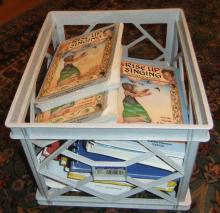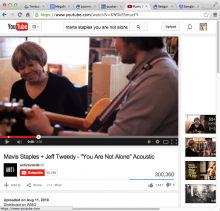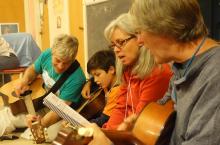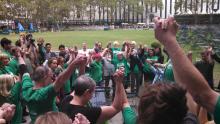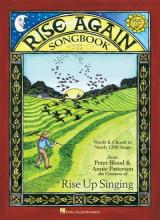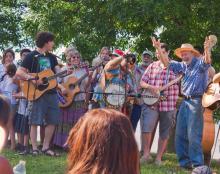Pete Seeger and Friends
Article in Friends Journal, January 31, 2014, issue:
Annie Patterson, Peter Blood, and Pete Seeger in Seeger’s home in January 2013. (Photo credit: Polly Wells)
Friends are certainly prominent among the many, many people around the world mourning the death and celebrating the life of Pete Seeger, who passed away on Monday, January 27, 2014. Although neither Pete nor his wife, Toshi, was a Friend, the couple had many connections with Friends. (Toshi predeceased Pete in July 2013.) In my work with Pete over the years, I was privileged to see and hear first-hand how he both inspired and contributed to Friends and Quaker causes, as well as took inspiration from them.
Poughkeepsie Friends MeetingPete and Toshi raised their kids in Beacon, N.Y. (about a half-hour’s drive south of Poughkeepsie), in a log cabin, which Pete had built himself, that overlooked the Hudson River. Pete once told me (Peter) that for a number of years they took their three children to First-day school at Poughkeepsie Meeting, but Pete and Toshi did not attend. When the kids got a little older, they started to ask why they had to go to meeting if their parents weren’t going. That was the end of that.
The Seegers’ grandson Kitama Jackson attended Oakwood Friends School in Poughkeepsie for a couple of years in the ’90s. The students there were treated with several performances by Pete during that period.
Quaker testimoniesPete grew increasingly concerned about war during the ’50s and ’60s. His song “I Come and Stand” is about the bombing of Hiroshima. Many Friends got to hear and be led by Pete at antiwar rallies in Washington, D.C, during the Vietnam Era. He was censored when he tried to perform “Waist Deep in the Big Muddy” (a satirical song about then president Lyndon B. Johnson and the Vietnam War) on network TV on the Smothers Brothers Show. He was similarly aligned with Friends concerns in his support of the Civil Rights Movement and environmental work, especially through his work in founding Clearwater to clean up the Hudson River Valley.
HUAC hearingPete took a principled stance in response to the witch hunt being conducted by the House Un-American Activities Committee (HUAC) in 1955. HUAC—like the even more notorious McCarthy hearings in the Senate immortalized in Arthur Miller’s play The Crucible (about the Salem witch trials)—focused heavily on “going after” leading figures in the film and music industries who were “aiding and abetting” the Communist agenda. Friends, of course, have often faced various forms of persecution for the principled stances they have taken, from the three Friends (including Mary Dyer) executed on Boston Common to the many twentieth-century Friends imprisoned for non-cooperation with the draft. A number of Friends lost their jobs, mainly as teachers, in the 1950s for refusing to sign loyalty oaths.
HUAC’s method was to bully those called to testify into giving incriminating evidence against themselves and others about their involvement in Communist Party activities. Those caught in their net, directly or indirectly, often lost their jobs and faced other forms of ostracism as a result. Some of those called chose to plead the Fifth Amendment against being required to testify against one’s self. Others chose to cooperate with the committee. Many including Arthur Miller and Lee Hays (Pete’s fellow member of the Weavers) refused to answer questions about their political beliefs or about others on conscientious grounds and were convicted of contempt of Congress.
There is a wonderful online account of Pete’s hearing on August 18, 1955. He handled the inquiries of the committee with a wonderful mixture of conviction and humor. Pete was glad to talk about his work as a singer and sing any of the songs they were asking about, but refused to testify about his political associations or his associations with any other people. Whenever they asked if he sang for Communists or pacifists, he would say that he sang for “Americans of every political persuasion” and for pacifists and soldiers alike. It reads like a Franz Kafka novel. He was convicted of contempt of Congress and sentenced to a year in prison. His family fully expected him to be imprisoned at any time. Because he expected to go to jail soon, he took every job he could, which created enormous strain on the family, so much so that Toshi famously exclaimed, “Never again. Next time no appeal. Let him go to jail!”
Personal inspirationLike so many others, Pete Seeger was an early hero of mine, musically speaking. I had a couple of his LPs (“Sing Out with Pete” and “We Shall Overcome”) in high school, and my friend Russell Boulding loved to sing “Talking Union” on his left-handed guitar at our Saturday night youth get-togethers in the Ann Arbor (Mich.) Meeting meetinghouse. I saw Pete in concert in 1964 when I was working at anAmerican Friends Service Committee summer workcamp in Bristol, Pa., and was blown away by his performance. In college, I began having dreams about Pete. They were nothing like he really is: he was kind of a prophet dressed in a long colorful robe (like Joseph’s coat of many colors). In my dreams, I yearned to receive something powerfully important from him. Little did I imagine not only how much his life and work would shape my own, but also that we would grow to be close friends and collaborators over time.
Rise Up SingingWhen I began work on the songbook Winds of the People (an underground predecessor of Rise Up Singing), I called up Pete to ask for advice on how to obtain copyright permissions from large music corporations. His advice: “Don’t bother to ask; they’ll only say, ‘No’!” (His own music publisher was not amused when she heard this story years later.)
The book was produced mainly with the volunteer labor of people living at the Movement for a New Society life center in West Philadelphia. It was printed by David Finke, a member of Fifty-Seventh Street Meeting in Chicago, Ill., out of his basement and soon became a fixture of the noon and pre-plenary sings at Friends General Conference (FGC) summer gatherings. He was an enthusiastic supporter of that sing-along collection.
Pete wanted to support this collection since it encouraged exactly the kind of grassroots, people’s music that he believed in so fervently. After a few years of selling that book (mainly out of Friends’ homes), we (I was now partnered musically and in life with my wife, Annie Patterson) decided to make the book legit. Annie and I quickly determined that a good approach would be to have it published bySing Out! magazine, which Pete had founded in 1950. When I brought the proposal to Sing Out!, Pete and Toshi enthusiastically supported it. His manager, Harold Leventhal, was critical in obtaining song licenses from just the kind of large music corporations that Pete had earlier urged me to avoid six years earlier. Pete made lots of suggestions on songs to include in this new songbook.
The foreword that Pete wrote to Rise Up Singing is stunning. Since the songbook sold upwards of a million copies, he used to joke that this was his most successful writing ever. Pete was a huge supporter of the new songbook and frequently talked about it at his concerts.
AutobiographyA few years later, Harold Leventhal asked Pete to create a songbook of his own songs to avoid losing his own connection to the songs and the loss of royalties that entailed in several famous court cases. Pete approached me and said that because he liked the work I had done so much on Rise Up Singing, he hoped I would edit his new book. The book Where Have All the Flowers Gone ended up being much more of an autobiography than a songbook. It is filled with his own accounts of his life; the process of pulling together a variety of sources in creating songs; his ideas and beliefs about creativity, multiculturalism, religion, peace; and a host of other subjects.
While we were working on the book, he slept for a few days in our housemates’ bed while they were out of town. (We were renting out our third floor at Tanguy Homesteads in Glen Mills, Pa., to a Quaker couple at the time.) When they got home and discovered he had been sleeping in their bed, they told me that they didn’t wash the sheets for weeks because they wanted to enjoy his presence!
Coming to FGC GatheringIn the late 1990s, conference planners for the FGC summer gatherings told me they had been trying for years to convince Pete to come and do a concert at a gathering. They asked me if I could try and persuade him to attend. They had the idea of offering him some kind of special celebration of his and Toshi’s years of work for peace and the environment. I knew that that would never work, as both Pete and Toshi hated to be honored or to have a fuss made over their own gifts or accomplishments.
I agreed, however, to talk to him about the gathering. I asked him: “Is there anything that could persuade you to come to this conference?” He confessed that it seemed too much like “preaching to the converted” and that he preferred to work with different populations less familiar with his ideas and work such as union workers, farm laborers, or children. So I said, “Well, FGC gatherings have terrific young people’s programs, and they would just love to have you come and sing and tell stories with all the different groups of kids there.”
As a result, Pete came and spent several days at the 1997 gathering held at James Madison University in Harrisonburg, Va. He did spend a lot of time with the children of various age groups and the junior high and high school groups. Many Friends remember most fondly his evening performance in a gym, which was attended by about 2,000 Friends. One whole wall of bleachers was filled with young people. Pete brought with him a log of wood and a couple of axes, and he and another performer that came with him took turns swinging their axes at the log as they sang one of the songs! The gym was filled with glorious singing that day and Pete was celebrated by all present—even if we didn’t embarrass him by making a big fuss over him or Toshi directly.
Pete and GodIn Where Have All the Flowers Gone, Pete says that he grew up in leftist circles who believed that religion was the “opiate of the people.” By the time he wrote that book at age 74, he said he had made his peace with the word “God.” In the chapter entitled “The Great Book,” he writes about his growing appreciation for spirituality and the positive role religion often plays in people’s lives and movements.
Recent yearsAround 1998 or 1999, Pete joined a number of Friends (Roger Conant, Sally Gordon, Johanna Halbeisen, Claire Brandenburg Taylor, Anne Wright, and several others) on an early selection committee for our new songbook entitled Rise Again, which is only now nearing completion.
Pete visited Westtown Friends School when our oldest son was in middle school there in 2001. (Annie and I were teachers at Westtown for the 2001-2002 school year.) The students loved spending time and learning from him—but perhaps the parents appreciated him coming even more. He has undoubtedly had visits over the years to many other Friends schools besides Oakwood and Westtown.
In January 2013, a Canadian writer and documentary filmmaker Polly Wells, filmed Pete in his home as he talked to Annie and me about group singing; Rise Up Singing; and our new songbook project,Rise Again. Polly has many close ties to Friends, including sibling connections, Quaker ancestors, and attending Germantown Friends School. We were fortunate to have had Pete’s grandson, Kitama (see above), help out on the film crew that day. During the filmed conversation, Pete dictated a brief preface for Rise Again, which we plan to use. The whole event was completely unscripted and will be included in a film Wells is directing on the revival of group singing. Our visit concluded with me asking Pete if he would sing a song with us; we decided to sing “Song of Peace” (#37 in the 1955 Hymnal for Friends and #304 in Worship in Song). Little did we know that would be the last song we would sing with Pete.
Pete was not a Friend. But he has done more for building the kind of world we long for in terms of peace, racial justice, and the healing of the planet, than any Friend I know. I believe the deep heart transformation that his music has engendered is profoundly spiritual work.
For more information on Pete’s life, work, and recordings, go to: www.riseupandsing.org/seeger.





